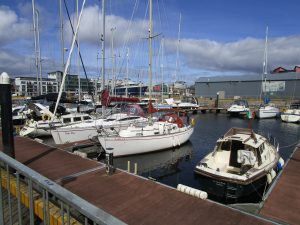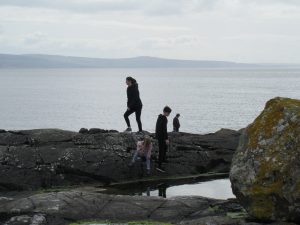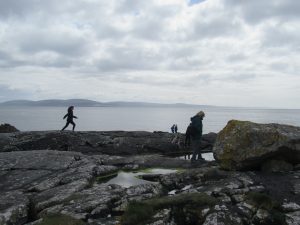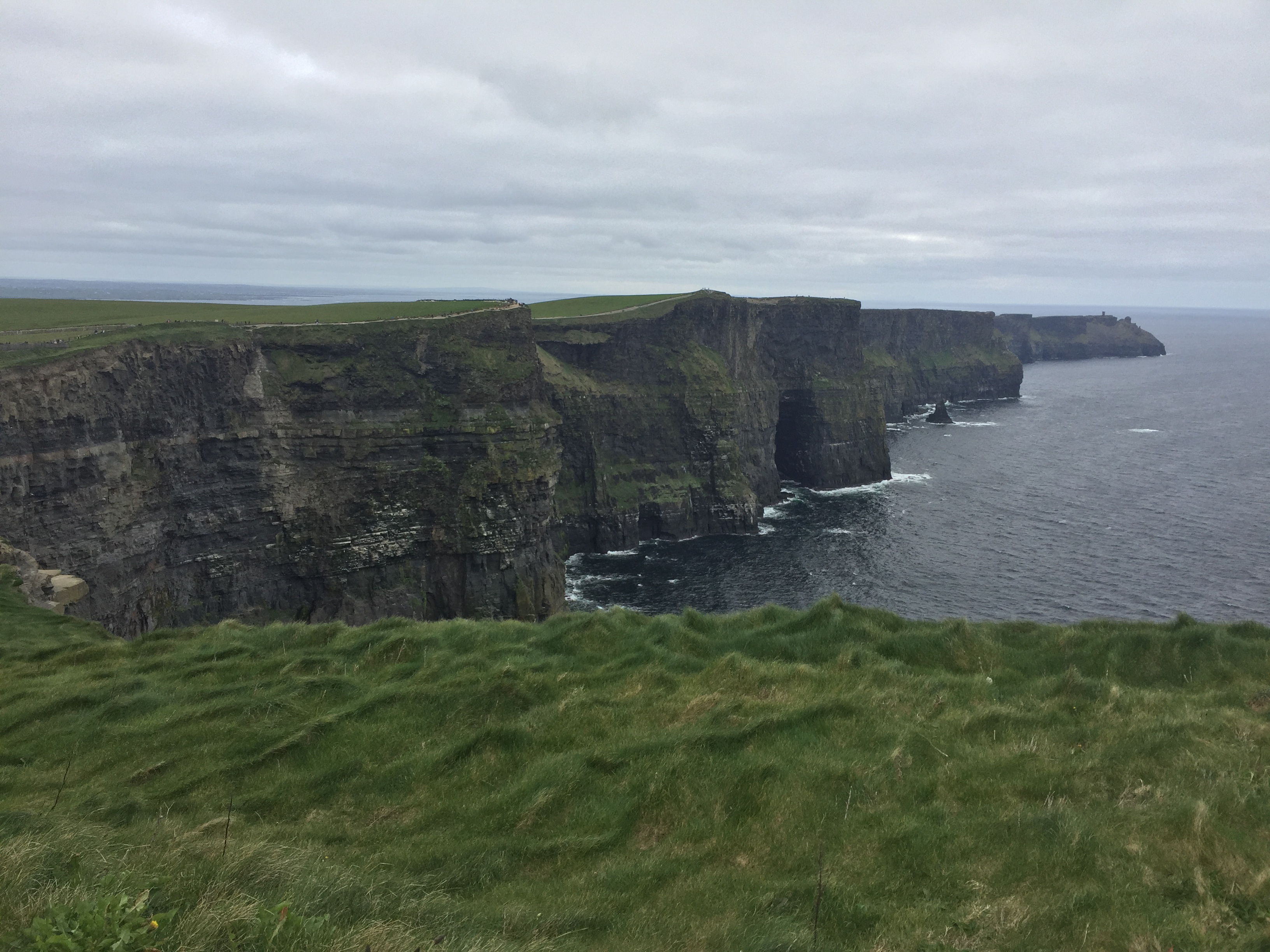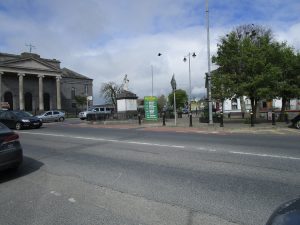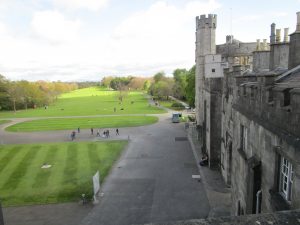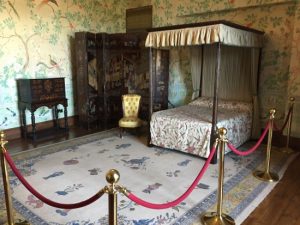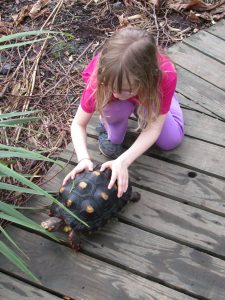Let me say this: Ed Sheeran’s song is a travesty. Plus, I always think of it as ‘Galway Grill’ because that’s what he ends up getting tattooed on his arm in the music video. He isn’t even Irish. If you want to hear the real ‘Galway Girl’, here is is:
It’s based on a true story and when he says ‘a fine soft day’ it’s Irish for ‘it was raining’.
But I digress.
I left you back in the Burren amongst the voles and eagles.
The following day it was time to take a little whirl around the Salthill Prom so we set the GPS for Galway city, saddled up and rode out. Driving in County Galway is an exercise in patience because all the back roads are very narrow and bordered on both sides by little stone walls. Two cars passing have enough trouble, and then you come across a combine harvester. It’s picturesque as all get-out but not for the faint-hearted. Probably you wouldn’t bother with panel-beating if you lived there; you’d just accept that scrapes along the door panels are a way of life.
We parked at the wharf, admired a very fine scrap metal collection and went to the Spanish Arch.
The city wall dates from 1584 and was built to protect the quays. In the early 18th century the quays were extended and two arches were built to allow access through the wall to the new part, the Long Walk (as mentioned in the song above). It has no connection with Spain and is called the Spanish Arch for no reason whatsoever. In 1755 the two arches were partially destroyed by a tsunami caused by an earthquake in Lisbon.
We headed off along the main street into the Latin Quarter. Funny thing, I thought. I’ve been to Galway a few times before, back in another life, and I don’t remember there being a Latin Quarter. Sure enough, Josh, having had the same thought, looked into it and found that the name was created by a marketing department in 2009. If you didn’t know that, it would reek of ancient heritage, wouldn’t it? Never mind. At least they didn’t go with Chinatown or Little India.
Name aside, the (ahem) Latin Quarter is pretty awesome. It’s the old part of town with the narrow cobbled streets and the Irish dancers and trad music buskers and the many gastro-pubs. Josh and I were hoping to find The River God, a restaurant we have happy memories of (and when you’re among shops that have been trading since the middle ages, you do get to have some optimism about favourite restaurants still being there a mere fifteen years later) but although it apparently still exists it was hiding among the clutter and maze of the little alleyways and wonky streets that pre-date the concept of town planning by quite some time.
We found lunch despite the absence of The River God and headed west towards the heartland of Irish language and culture, the Gaeltacht and Connemara. You have to know where you’re going because the signs, bi-lingual everywhere else in the Republic, are often in Irish only around here. We stopped for a good long play in the rock pools at Spiddal
then, having put all the people with soggy clothes in one car and me in another, carried on through Tearmann Eanna, Costelloe, Camus Oughter, Screebe, Maam Cross, Quiet Man Bridge (from the movie), Oughterard, Moycullen and Barnacranny, and back through Galway to our temporary home in Ardrahan, near Gort (apparently this last name means something if you’re enough of a geek. I wouldn’t know).

There are still plenty of thatched roofs to be seen, including new ones. Each thatcher has their own distinctive pattern along the top.
The next day the youngest and oldest of us paid a visit to the Burren Nature Sanctuary in Kinvara.
Irish alpacas have big thick sheep wool. They’re like sheep on stilts.

Emilia the micro-pig. She went on walks – well, runs – around the estate. And anywhere else she felt like.
Even the gypsy caravan had a fairy living in it.
 This is a stone field, used as a paddock and to keep stock safe at night.
This is a stone field, used as a paddock and to keep stock safe at night.
The Nature Sanctuary is a sort of kid-friendly beginner’s guide to the Burren flora and fauna. Ireland used to be tropical (we’re going back a really long way here) and there are fossils here from when the warm ocean waters covered it. There’s a boreen (ancient green road) and an ancient abandoned farming village. It has a turlough, or disappearing lake, a rare geological feature almost unique to Ireland that happens only in limestone karst regions such as the Burren. It’s a fresh tidal lake and disappears once every 11 hours as it drains down through the limestone through cracks and fissures formed by the mildly acidic rainwater dissolving the stone.
There was also a nice playground, a special birthday party yurt with a throne for the honouree and a good café. All boxes ticked.
After lunch we met up with the others and headed for the Cliffs of Moher. The Cliffs are one of Ireland’s most famous attractions, with over a million visitors a year, but I have to say that I find them a bit underwhelming. It’s Born In NZ Syndrome again: I am used to big, spectacular landscapes.
Since I was last there a new visitor centre has been built and I will say, it’s impressive. It’s built into the hill, Hobbit-style, so as not to spoil the contours of the landscape. Inside you can find out about the geography, geology, bird and marine life, and history of the area, and watch a short film from the perspective of a bird flying around the cliffs and diving into the sea. That was pretty awesome, and some of us had to be bribed to leave the room where it was playing on endless repeat.
Here you can see O’Brien’s Tower, built on the highest point of the cliffs in 1835 by Sir Cornellius O’Brien to give the Victorian tourists somewhere to stand and look, or to impress the lady he was after, depending on whose version you believe. From here on a clear day you can see to the tip of Clare and beyond to the mountains of Kerry in the south, the Twelve Bens in Connemara in the north, and the Aran Islands to the west.
The following day we headed home. We stopped for lunch in Nenagh, Co. Tipperary, which features a cute little castle in the middle of town and a seemingly permanent green sign outside the tourist information centre listing the dates and names of the 1916 executions.
Contrary to popular belief, it wasn’t a long way at all.
Those photos were taken by someone who didn’t quite have the knack of the zoom button.
We detoured through Kilkenny to see the wonderful Kilkenny Castle and the National Reptile Zoo.
Castles come in two types, broadly speaking. You have your big old ruin, which is impressive from the outside, and you have more of a palace type, impressive from within. Kilkenny, while perfectly adequate from outside, has its real magic indoors. It is one of my highlight memories from our last trip here when even the crippling morning sickness of the time couldn’t ruin the experience. We went on a guided tour and heard a thousand stories, and saw a thousand details, and I loved them all. My particular favourite room is the Chinese bedroom because the wallpaper, covered in lovely Chinese-style birds, was entirely hand-painted.
Kilkenny Castle has been restored relatively recently – just before we visited last time – and the current wallpaper is a printed reproduction of the original, and this photo certainly doesn’t do it justice, but it was marvellous. The tour guide talked about the restoration; about how they reproduced the colours and designs of French silk poplin wall coverings from tiny remnants of the original that had been stuck under skirting boards, and how they had a replacement carpet woven by the same firm who’d made the original back in the early nineteenth century, possible because a) the firm is still going and b) it was easy to trace them because the family had kept the receipt. None of this ‘keep everything for seven years’ rubbish. The Butler family owned the castle for six hundred years, and if that’s not a totally legitimate excuse for hoarding, I don’t know what is.
For a complete change of pace, our last stop was the National Reptile Zoo.
There was a tarantula like a dinner plate. And that white snake up there, you can’t get any perspective from the photo but he was like a tree trunk. In fact there wasn’t anything in there that you’d want to meet in a dark alley. It was great.
To finish, here’s one from the Birds of Prey centre that brought to mind a much-missed friend of Daniel’s:
And that’s all from Galway.

